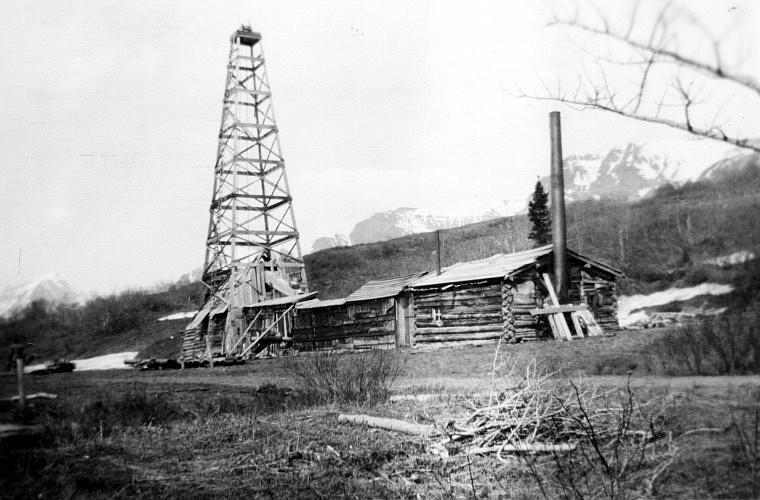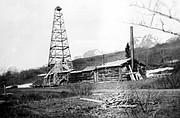Montana's first oil well was drilled at Kintla Lake in 1901
The history of oil in Montana began in an area that never had any substantial development of the natural resource — the Flathead Valley.
The state’s first oil well was drilled by Butte Oil Co. in 1901 in the Kintla Lake area that’s now part of Glacier National Park.
American Indians and fur trappers knew about oil seeps in that area and early-day prospectors wondered about the potential for oil when bear hides sold at Tobacco Plains smelled of kerosene, according to a historical overview of mining in Montana compiled by the U.S. Forest Service.
Prospectors filed the first oil claims in Montana in 1892 for the Kintla Lake area, but any hopes of drilling at that point were thwarted by the financial panic of 1893. A subsequent depression forced would-be oil developers to temporarily scrap the oil district.
Butte Oil Co. revived interest in the Kintla oil fields in 1900.
At the time the area was “practically inaccessible,” Forest Service records note. It was reached from Tobacco Plains via a trail over the Whitefish Divide, along the “coal trail” on the west side of the North Fork of the Flathead River, or along the “Canadian trail” on the east side of the Flathead River from Belton at West Glacier.
Butte Oil hired workers to build an eight-foot-wide wagon road in 1901, and drilling equipment from Pennsylvania was hauled to Kintla Lake.
Drilling began in 1901, other oil companies formed and the state’s first oil “boom” was on, according to an article by Jerome DeSanto called “Drilling at Kintla Lake: Montana’s First Oil Well,” published in the Montana Magazine of History.
Speculators filed oil claims in the area and the buzz among oil promoters was palpable.
A 1986 article by Patricia Bick, “Homesteading on the North Fork in Glacier National Park,” included a quote from a magazine writer in 1901 that summed up the excitement over the Kintla oil field:
“Perhaps there is no more beautiful region in the whole Northwest than this virgin wilderness, which the enterprise of man will soon convert into a populous and busy territory with all of the industries of a great oil field in full blast.”
It was not to be.
That first oil well on the shore of Kintla Lake was drilled to 1,400 feet, but during the winter of 1902-03 fire destroyed much of the operation. Wells in the area never made enough money to justify the expense, and by 1912 Butte Oil’s claims were declared void. Another oil company built a derrick a few miles below Kintla Creek, but drilling halted in 1903 due to a lack of capital.
Oil was discovered in the Swiftcurrent area on the east side of the mountains in 1903, where another short-lived boom occurred. That, too, dwindled after a few years of production “as the wells were lost to penetrating water,” according to a 1953 article written by Don Douma for Montana Magazine of History.
In the late 1940s and early 1950s oil and gas companies pressured the Forest Service for leases in the Bob Marshall Wilderness, but no leases were granted because they were seen as incompatible with wilderness preservation.
The first-ever mention of oil in Montana comes from an account from an emigrant wagon train at a Bozeman Trail crossing of the Big Horn River, according to Douma’s historical narrative. Settlers used a thin coating of crude scum to grease their wagon wheels.
Sixteen years later, a rancher seeking a new cattle range north of the Musselshell River wrote in his journal: “There are petroleum indications all through here and some day Montana will produce oil.”
They were prophetic words.
In 1922 oil was discovered in the Kevin-Sunburst oil fields in Montana. Two years later a small refinery opened to process crude oil from those early wells. Texaco acquired the refinery in 1928 and became known for producing leaded gasoline during and after World War II, Douma noted in Montana Magazine of History.
One of the worst environmental disasters of its time was documented in 1955 when Melvin Linnell tried to light his hot-water heater and was burned in an explosion in his basement. His house was 300 feet from the Sunburst refinery.
Texaco traced the explosion to a leak in an underground pipeline at the refinery. Subsequently, residents of another home just north of the refinery reported gasoline and water seeping into their basement.
Between 1955 and 1957, Texaco recovered 4,344 barrels, or 182,448 gallons, of gasoline, some mixed with water, from underneath Sunburst’s neighborhoods, according to a Great Falls Tribune timeline.
Texaco closed the refinery in 1961 and a salvage company demolished it. The company’s wells were plugged and abandoned in the mid-1970s, but it wasn’t until 2001 that a lawsuit was filed claiming thousands of people could have been exposed to dangerous chemicals from the refinery and gas plume.
In 2007 the Montana Supreme Court affirmed a Cascade County jury order for Chevron/Texaco to pay $15 million to the town of Sunburst for cleanup and $25 million to 80 plaintiffs for punitive damages.
The Williston Basin, which straddles North Dakota and Montana and extends into Canada and northwestern South Dakota, was named by Dr. W.T. Thom Jr., a geology professor at Princeton University who made a reference to the basin in a paper he presented to the Geological Society of America in 1923.
As early as 1912, Thom worked as a college student with field parties of the U.S. Geological Survey, Douma noted. His discovery of coral led him to believe the area once was covered by an ancient sea and possibly contained crude oil.
One of his reports, dated May 5, 1921, is titled: “Possible Oil in Northeastern Montana.”
Oil was first found in the Williston Basin along the Cedar Creek Anticline in southeastern Montana in the 1920s and 1930s between Baker and Glendive. And between 1924 and 1951 there were close to two dozen attempts at drilling about 40 miles east of Williston, N.D.
But it was the well drilled on the Clarence Iverson farm south of Tioga, N.D., that gets the credit for the first major discovery in the Williston Basin, according to “Rockin’ the Bakken,” a publication of the Williston Area Development Foundation.
At the time, the Iverson well was “a novelty and curiosity” to residents in the area.
“Skeptics scoffed, particularly since the closest supply company was located more than 500 miles away at Casper, Wyo.,” according to Rockin’ the Bakken.
By the time the drill bits had dug to 10,500 feet on April 4, 1951, the Clarence Iverson was considered a success and the discovery well of the Williston Basin.
A month later, 30 million acres of North Dakota were under lease, and the Williston Basin was off on the first of several boom cycles.
Prior to the current boom sparked by new horizontal drilling and hydrofracturing technology that allows companies to tap the massive Bakken Formation, the Williston Basin experienced its last major boom in the late 1970s and early 1980s.
An April 2008 U.S. Geological Survey report estimated the amount of recoverable oil using updated technology within the Bakken Formation at up to 4.3 billion barrels. However, various other estimates place the total reserves, recoverable and nonrecoverable with today’s technology, at up to 24 billion barrels.
The most recent estimate places the figure at 7 billion barrels.
By comparison, the Prudhoe Bay oilfields on Alaska’s North Slope have produced more than 12.8 billion barrels of oil since 1977, according to the Arctic National Wildlife Refuge website. That reserve originally contained about 25 billion barrels of oil.
Features editor Lynnette Hintze may be reached at 758-4421 or by email at lhintze@dailyinterlake.com.



